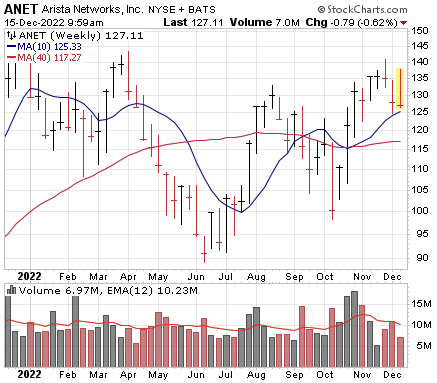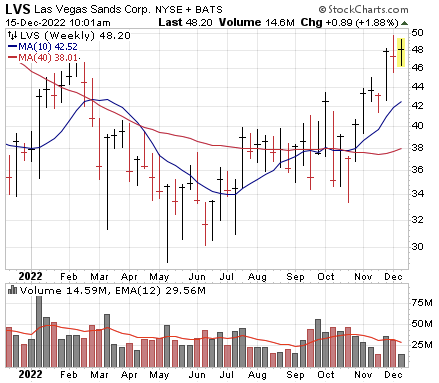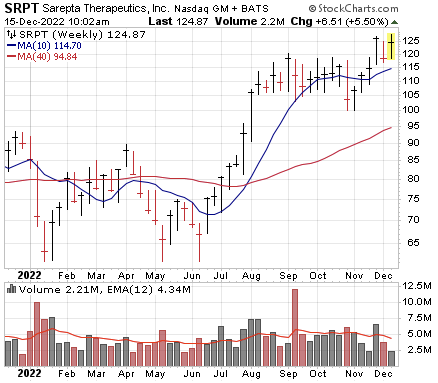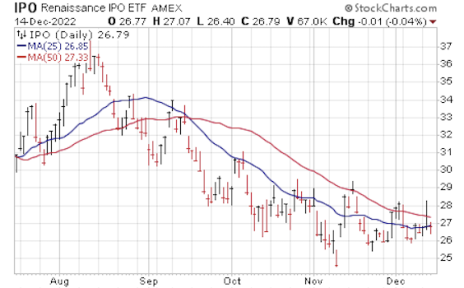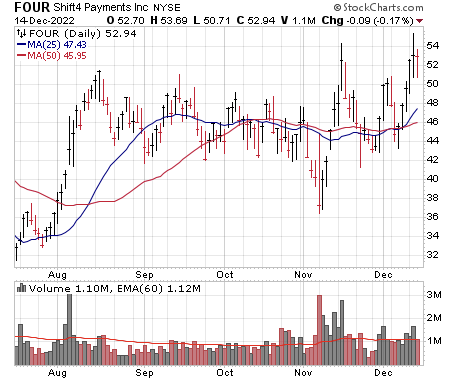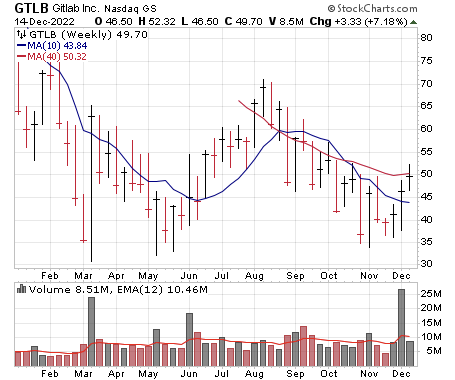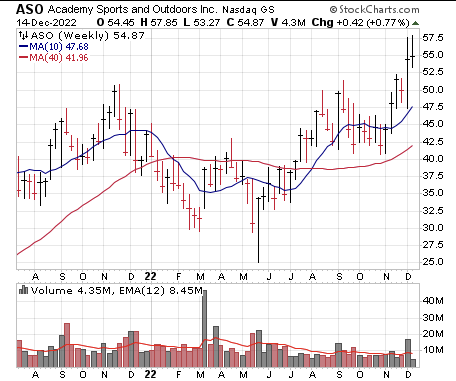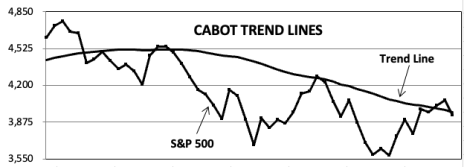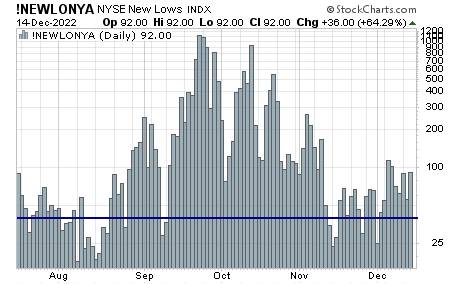Patience Is (Still) a Virtue
We led with this title back in early May, when the market was cascading lower as fears of everything—the war in Ukraine, an inverted yield curve, a tightening Fed, you name it—had the bears running wild and growth stocks imploding. The indexes cascaded to a temporary low a week later, and not much has happened to get the bulls excited since then—while the indexes aren’t much lower (net-net) in the past seven months, no rally has stuck.
In other words, patience was the right advice back then … and we think it remains the correct advice today. To be fair, despite today’s horror show, we remain in a bit of a middle ground when looking at the evidence: Our Cabot Tides are still holding onto their buy signal by the skin of their teeth, and other measures have also improved … though not enough to produce other green lights. Growth stocks are still finding resistance at key levels and breakout areas … though in recent weeks, any rejections have (generally) been less severe, with more names also holding support. And so on.
Of course, we’re not aiming to own stocks that are “not going down”—we want to own stocks that are actually going up, and there still aren’t many of those around. Plus, today’s post-Fed ugliness effectively has put the Tides itself back on the fence.
Bigger picture, the stage is certainly set if the bulls want to step up. While not every sentiment indicator is deeply negative (you’ll never see 100% of things line up in one direction), there’s little doubt most investors (big or small) are leaning bearish and/or have lots of cash. And the fact is that, since late September, all areas of the market have put in a good amount of constructive work, with selling pressures easing and some decent setups taking shape. We’ll see what happens after today’s selloff, but for the most part, the minor improvements we wrote about last issue are still in place.
Even so, as has been the case all year, we need to see the market and new leaders start to move before getting involved in more than a small way. Practicing patience isn’t sexy and doesn’t strike up conversations at holiday parties—but doing so has helped avoid a lot of bombshells so far this year.
What to Do Now
Remain defensive but keep an open mind. We sold our half-sized stake in Albemarle (ALB) more than a week ago, leaving us with nearly three-quarters of the portfolio in cash. We’re comfortable holding onto our four remaining positions, all of which act well enough for now, and our watch list continues to contain many high-potential names; we’re not ruling out a nibble here or there if things firm up. But we’ll continue to hold off on any major buying until the buyers return in force. We have no changes tonight.
Model Portfolio Update
The market has retrenched some since our last issue, with most growth stocks taking at least a short-term gut punch, and today’s post-Fed selling was another smack. At the moment, though, nothing has decisively changed with the evidence—our Cabot Tides are still technically positive (on the fence) though nothing else has been able to confirm that.
Individual stocks had been showing a bit of improvement—they’re still having a rough time getting through resistance, but the selling pressures have been sporadic (one or two days usually), resulting in many potential leaders etching out a few weeks of tighter ranges. If that can continue, it would be a step in the right direction.
Of course, we’ll see how things go following yesterday’s Fed decision; we’ve seen the market change character for the worse a few times this year after rate hikes, and maybe this becomes the catalyst for the latest leg down. If so, we’ll pare back further, but we’re standing pat tonight, remaining patient as we hold an outsized (73%) cash position.
Current Recommendations
| Stock | No. of Shares | Portfolio Weightings | Price Bought | Date Bought | Price on 12/15/22 | Profit | Rating |
| Dexcom (DXCM) | 802 | 5% | 117 | 12/2/22 | 116 | -1% | Buy a Half |
| Enphase Energy (ENPH) | 311 | 5% | 305 | 11/11/22 | 314 | 3% | Buy a Half |
| Halozyme (HALO) | 1,776 | 6% | 54 | 11/11/22 | 57 | 6% | Buy a Half |
| Wingstop (WING) | 1,319 | 11% | 144 | 10/7/22 | 156 | 8% | Buy |
| CASH | $1,368,753 | 73% |
Albemarle (ALB)—ALB was sold last week as the initial failed breakout led to more and more selling—and we also saw other lithium stocks hit the skids, too, with its main peer slipping below its 200-day line. (ALB itself did the same by a hair today.) It’s possible the stock rights itself down the road and the lithium story plays out as most expect, but the recent weakness has been abnormal in our book, and the fact that many other commodity prices (and commodity stock) have hit the skids isn’t a great sign, either. At the very least, we think there will be peppier names to own if/when growth stocks get going—and if they don’t, we think ALB could have risk to the downside. We sold and are holding the cash. SOLD
Dexcom (DXCM)—DXCM has had a couple of pieces of good news this month, starting with a broader reimbursement approval in Japan for its G6 CGM, which should open up a larger market for the product in that country (Japan is generally a big medical device market). And then, last week, the FDA gave the thumbs up for the firm’s next-generation G7 device, which is already rolling out in Europe and should gain traction in the U.S. early next year; it’s approved for all diabetics at least two years old. The news was expected, but it still led to a brief pop to new highs … before the half-expected rejection at resistance that you can set your clock to these days. Even so, the selling really hasn’t been damaging to this point (shares are still north of their 25-day line even after today), and we believe DXCM remains in pole position to move up if the market gets out of its own way. For now, we advise sitting tight with your half-sized stake; if you don’t own any yet, we’re OK starting a position here or on dips. BUY A HALF
Enphase Energy (ENPH)—Like most potential leaders, ENPH has been choppy of late and taken the occasional body blow (including today), but it’s held up in the same general area for the past few weeks and isn’t that far from new-high ground; it’s a similar story for most solar stocks, which have bobbed and weaved but held their ground. Interestingly, there’s been no meaningful news from (or much analyst commentary on) the company since earnings a few weeks back, but the writing remains on the wall for continued big increases in sales and earnings both in the U.S. and Europe as the dam has broken in the industry; year-to-year worries about subsidies and other factors have been (mostly) replaced by certainty, allowing firms to plan more big projects going forward. Ideally, ENPH decisively breaks out soon as growth stocks go bananas, and we’ll average up on our stake, but obviously, we’re open to anything. Right now, owning a half-sized stake and giving it some room to breathe makes the most sense. We’re OK grabbing some shares here or on pullbacks if you’re not yet in. BUY A HALF
Halozyme (HALO)—HALO was another name that got whacked with just about every growth stock a couple of weeks ago, but once again, the damage was reasonable, and the stock has steadily marched back toward its highs. And why shouldn’t it? The royalty story here is strong and should be long-lasting, with one analyst saying Halozyme will likely remain Big Biopharma’s partner of choice for many years, driving sustainable 20%-plus growth for many years (likely into the 2030s). Near term, approval for Argenx’s Enhanze-enabled offering early next year (the FDA decision date is no later than March 20) is expected, and any rapid uptick in sales from there should goose royalties further. Throw in the stock’s huge launching pad (February 2021 through November 2022), big earnings estimates for next year, resilience in the biotech sector and a reasonable valuation (we’re not valuation-based investors, but ~22x next year’s estimate is hardly nosebleed territory) and we have high hopes that HALO can finally get moving. Right now, the stock is still extended to the upside, and combined with the market, we’re not in a rush to fill out our position quite yet; another wobble or two as the moving averages (the 50-day is down near 50.5 and rising) catch up would be tempting. We’re optimistic the next big move here will be up. Hold on if you own some, and if not, try to start a position on a pullback of two or three points. BUY A HALF
Wingstop (WING)—Stop us if you’ve heard this before: WING hasn’t been making much upward progress in recent weeks, but it’s constructively consolidated its big earnings move in October, held up above key support thus far (it bounced off its 50-day line last week and is still above those lows even after today) and isn’t far from multi-month highs—i.e., it looks ready to go if the environment improves. While near-term recession fears have toyed with some consumer stocks, many factors are improving, too; falling energy (and gasoline) prices, as well as lower interest/mortgage rates, falling inflation and a still-strong job market should help the consumer spending cause. Of course, we’re not macroeconomic investors, so we’ll just stick to the growth story (remains solid, with wing price deflation likely to help boost already-great store economics) and chart, both of which look proper. We’ll stay on Buy. BUY
Watch List
- Academy Sports & Outdoors (ASO 54): ASO staged a powerful breakout after its Q3 report, which saw sales and earnings top expectations, share buybacks continue and the cookie-cutter story (30%-plus store bump over the next five years) begin to play out. See more later in this issue.
- Arista Networks (ANET 126): ANET isn’t running away on the upside, but it’s set up nicely after a year’s worth of correction and consolidation—and the firm’s networking gear continues to be in big demand. See more below.
- ASML Inc. (ASML 586): We’re very intrigued by the fact that chip equipment plays (usually very cyclical) are acting great, and ASML is basically a monopoly in super-high-end systems for etching advanced chips. The stock was hit with everything else today but looks to have changed character for the better back in October.
- Axon Enterprises (AXON 171): AXON has been correcting following a good-sized ($600-plus million, about 5% of the market cap) offering of convertible notes (which are dilutive), though so far, it’s only back down where it gapped up on earnings in November and well above the 50-day line. Frankly, if the stock sat around for the rest of the year, it wouldn’t be a bad thing.
- Celsius (CELH 107): CELH nosed to new price and RP peaks recently, but 120 has been a barrier and today was sloppy. We’d prefer to see the stock settle down a bit (it moves an average of 7 points per day from high to low!), but even so, shares definitely looks like they want to get moving if the market does.
- Impinj (PI 109): PI is a bit thin and does have a bit of boom-bust flavor to it with a couple of OEMs making up a huge chunk of its revenue, but demand consistently overwhelms supply for its endpoint ICs and the stock’s uptrend is still intact.
- Las Vegas Sands (LVS 49): LVS appears to have finally changed character, rallying to multi-month highs on the prospects of China’s re-opening. See more below.
- Shift4 (FOUR 52): FOUR has been tossed around multiple times due to the environment (selling at resistance) and some recession worries (which hit payment stocks), but it keeps snapping back, the projections look great and the story is excellent. See more later in this issue.
Other Stocks of Interest
Arista Networks (ANET 126)—We had very high hopes when we bought into Arista Networks late last year—its various high-speed networking gear (and, importantly, the software used on the devices) was in big demand for a variety of end uses, but especially with the so-called “cloud titans” (Arista’s term) like Meta, Amazon, Microsoft and Google, who were entering a huge upgrade cycle for their data center and cloud operations after a couple of slow investment years (and after Covid accelerated demand for everything online). The stock, though, keeled over earlier this year with the bear market—but what’s interesting is despite all the economic headwinds, the fundamental story played out exactly as expected: Arista’s sales growth has actually accelerated all year as these big buyers step up and as it takes market share, and all of this happens in what is still a supply-constrained environment. And when you add in strength in enterprises campuses (small but doubling this year), it’s looking like the boom will continue through 2023—at a November analyst day, the top brass said revenues next year should grow at a 25%-plus rate as supply issues gradually ease and as demand remains buoyant, with earnings likely rising at a similar pace (and management is usually conservative with these outlooks); growth beyond that looks solid, too. To be fair, Arista’s business does go in waves, so any hint that it’s returning to a slower (10% or so) expansion pace after this ramp would be bad—but big investors certainly aren’t worried about that. Looking at the chart, ANET had what looked like its coming-out party last October before topping with the market the next month and going through the wringer. But today, shares are basically at the same level as they were back when the Nasdaq topped, which is clearly a sign of relative strength. Long story short, it looks like the past year is one big launching pad with a rapid, reliable growth story that should play out for the next few quarters at least to keep buyers interested—if growth stocks kick into gear, we think ANET can do very well.
Las Vegas Sands (LVS 49)—Back in November 2020, the broad market blasted off after the vaccines came out as investors discounted the world turning right side up and the economy powering ahead as individuals emerged from cabin fever. We see a potential follow-on opportunity setting up in China—over there, the country’s Zero Covid policies (which have been ridiculously strict) are easing, and if that continues, it doesn’t take a savant to see that sales and earnings among many firms are set to boom. Las Vegas Sands, which we wrote up here in September, remains one of our favorite ways to play it: While the company still has Vegas in its name, it sold off those properties and is now exclusively focused on Macau and Singapore. Business has been horrendous—in Q3, Macau visitation in general was down 91% (!!!) from comparable 2019 (pre-pandemic) levels, while mass gaming revenue in the area was off 89%. Meanwhile, in Singapore, Q3 airport volume (for the location nearest the gaming section of town) was still off more than 45% vs. 2019. However, what’s interesting is that, despite its key area basically being basically offline and the other cut in half, business hasn’t been awful—the quarter saw EBITDA actually in the black (driven by Singapore, which was “only” down 25% or so from 2019) while revenues were up 17% from the year before. And as China and others come out of their lockdowns, there’s little doubt Sands is set to get back on track; Wall Street sees revenues up 91% next year as earnings leap back into the black—and the way these things go, our guess is even these figures will prove conservative as people start throwing money around. When we wrote about LVS in September, shares were set up nicely … but they went haywire with the market and lockdown news during the next few weeks, thrashing around from 40 to 35 to 43 to 34. Now, though, shares have come under control, with a persistent, powerful advance to seven-month highs as it challenges resistance near 50. Yes, there’s risk here, as China-related names are susceptible to potholes based on government decisions, but we think the odds strongly favor the Chinese economy getting back to normal in the months ahead—and Sands being one of the best plays. LVS is back on our watch list.
Sarepta Therapeutics (SRPT 125)—With Halozyme and Dexcom, we’re probably good for the moment when it comes to biotech and medical exposure in the Model Portfolio, but we continue to see some intriguing biotech names out there with solid growth and big potential as new drugs get approved. Sarepta’s focus so far is on a rare disease called Duchene muscular dystrophy (DMD), a very progressive genetic disorder that leads to muscle degeneration and weakness due to an off protein, and sadly the symptoms start early (usually 2 or 3 years of age; vast majority occurs in boys) and often leads to being in a wheelchair in the teens and death in the 30s, if not before. Sarepta has three drugs on the market today that target different offshoots of the same disease (Amondys, Exondys, Vyondys), and they’ve done well—in Q3, Sarepta’s product revenue totaled $230 million, up 24% from a year ago, with the top brass seeing $835 million or so from these products in 2022 as a whole. That certainly provides a solid base, but the real excitement here is about the company’s SRP-9001 drug (developed in partnership with Roche), which would be the first gene therapy for DMD patients and has demonstrated consistently good trial results across a range of studies and over many years; patients have much higher functional movement with the drug, with young patients seeing the disease’s progression slowed in a major way. All in all, many see the potential market for the drug in the $3 to $4 billion range, and SRP-9001 was submitted for approval a few weeks ago, and a decision is expected by May of next year—but Sarepta is so confident in getting a thumbs up that it’s already gearing up for a mid-year 2023 launch. The bottom line here is in the red as trials and research continue, but analysts see sales up 30%-plus next year and much more down the road as SRP-9001 hits the market. Institutions are expecting good things, too—SRPT was on its knees in the spring but soared in the summer to 18-month highs, basically held those gains for the next three months and, two weeks ago, popped to another new high. If the top brass can execute, Sarepta is going to get much bigger in the years ahead, and the stock should respond.
Keeping an Eye on IPOs
One truism throughout market history is that, when you get a big market wipeout, the new uptrend is almost always led in part by new leaders—and many of those leaders will be IPOs that came public during the bear market or later on in the last bull cycle (say, since mid-2020). As money comes out of old, popular mega-cap stocks, some will find their way into newer growth stories that institutions have done their due diligence on, with big money often coming in when the new bull starts.
Of course, right now, the tide is still going out when it comes to IPOs. One fund we follow to give us a clue to growth stocks as a whole (and IPOs of the past couple years in particular) is the Renaissance IPO Fund (symbol IPO), and it’s still stuck in the mud, barely holding above its spring lows and unable to get off its knees.
Even so, we always keep an eye on the market’s cradle so we’re on top of any liquid or glamour leaders that could emerge. And the good news is that, while nearly all much-hyped IPOs will get destroyed early in a bear phase, the longer it goes on, the more the potential wheat separates from the chaff. Today, we have a few names we’re keeping an eye on.
The first remains one of our favorite stories, though the stock continues to get tossed around week by week: Shift4 (FOUR), which we think can be the next leader in the payments space, with a unique all-in-one solution for its core areas (hospitality and restaurants) but also a bunch of new areas like gaming resorts (owner of the world’s largest casino has signed up), stadiums (tons of colleges are onboard), non-profits (St. Jude’s Hospital), travel (Allegiant Air) and even “sexy tech,” as the firm puts it (like Starlink). Current and projected growth remains great, though the stock remains super volatile. Even so, its price-volume action has been superb, and FOUR has moved back toward multi-month highs—we’re watching it closely.
Next is Gitlab (GTLB), which, on the surface, looks like just another software outfit that’s been tossed in the dustbin by the market. But we think the company has future leader written all over it: The firm bills itself as having the best “DevOps” platform out there, which basically means all the firms that need to develop software—and that is nearly every mid- to large-sized firm these days; 85% of firms are using some DevOps tools—can use its all-in-one solution to more efficiently do so. Gitlab now serves 6,469 clients (up 59% from a year ago), including 638 large clients (up 49%), with a same-customer revenue growth rate north of 30%. The stock needs work, but (a) it and its RP line bottomed back in March, which is interesting, and (b) GTLB surged on its heaviest weekly volume ever after earnings last week. It’s not ready for prime time now, but we don’t think it would take long to round out a solid launching pad if the market turns healthy.
Finally, we have Academy Sports & Outdoors (ASO), which has been on our watch list for a while—and whose Q3 report last week increased the odds it should have a good run when the bulls return to the market. Yes, sales (down 6%) and earnings (down 3%) slipped from a year ago while same-store sales (down 7%) did the same, but the top-line numbers were much better than expected, due in part to tons of share buybacks (share count down 13%; P/E ratio is 7). But more important, the top brass has started to embark on a big expansion in the store base, moving from 259 last year to 350 or so within five years (up 30%-plus), which one analyst thinks can goose the already-elevated bottom line by another $4 per share. It’s a special situation that also has a growth aspect, and the chart looks great, with ASO leaping from a huge launching pad on earnings last week.
There are others as well—Array Technologies (ARRY) has a simple, powerful growth story in the solar area; and Dutch Bros (BROS) remains a powerful cookie-cutter story that we keep a distant eye on—but the point is that at least a couple (and possibly many more) of the recent IPOs should prove to be fresh, explosive leaders of the next bull market.
Even the Growth Stock Pros Can’t Make Any Progress
It doesn’t take a genius to know that growth stocks have been on the outs this year, but if you follow a lot of stocks, you’ll eventually see the occasional name do well—which makes you wonder if you should be extending your line a bit further. Because of that, we’re always on the lookout for good measures of growth stock action—especially if that measures how active money managers are doing.
Enter the Investor’s Business Daily Mutual Fund Index, which comprises 20 solid growth stock mutual funds, generally with solid long-term performance. These are real money managers doing their best to navigate the bear market and isolate the best performers. But even here you can see the result: The Index itself is down more than 30% this year, and more recently, it’s been unable to get above its 40-week (black) line, with the recent rally now threatening to unravel.
We’re not revealing anything unknown here—growth stocks have been nailed this year, and even during the latest rally, they’ve done more “holding up” than “getting going.” That will change at some point, but the less-is-more environment remains in effect.
Cabot Market Timing Indicators
The market remained unable to make any real upside progress in recent weeks—though with sellers haven’t been able to take control, either. The key will be whether today’s post-Fed drubbing continues; if so, we could pare back further, but a few good days could change things quickly.
Cabot Trend Lines: Bearish
Like most everything else out there, our Cabot Trend Lines have shown improvement in recent weeks, but there’s still work to do before seeing a green light. As of this afternoon, the S&P 500 was 2% below its trend line, while the Nasdaq was more than 6% below its own 35-week line. A solid rally from here could be meaingful, but as always, we need to see it to believe it.
Cabot Tides: On The Fence
Despite lots of ups and downs of late, our Cabot Tides have held up fairly well, though now we’re seeing an important test as the indicator is on the fence—some indexes (like the Nasdaq) have already dipped below their lower (50-day) line, but others (like the S&P 400 MidCap, shown here) are testing their 50-days now. Technically, the intermediate-term trend remains up, and we don’t anticipate signals, but the next few days will be telling.
Two-Second Indicator: Negative
The Two-Second Indicator is still negative, though it’s similar to many other key measures we’ve seen—the readings have improved, but not enough to tell us the sellers have really left the building, with the occasional sub-40 reading overwhelmed by lots of 50 to 100 days. Like many measures, a strong rally from here could produce a green light, but it hasn’t happened yet, meaning the broad market remains unhealthy.
The next Cabot Growth Investor issue will be published on December 29, 2022.
